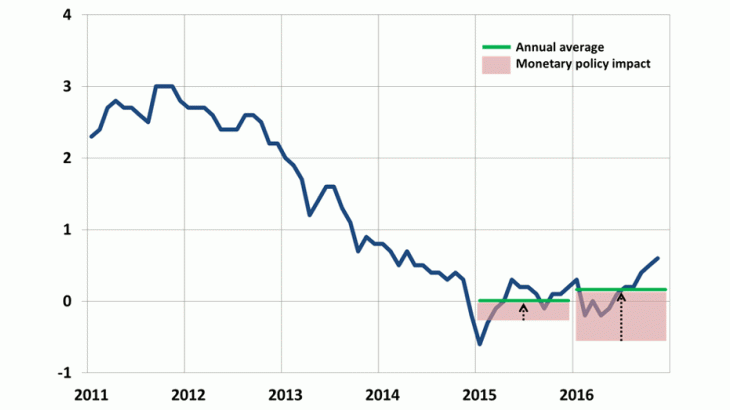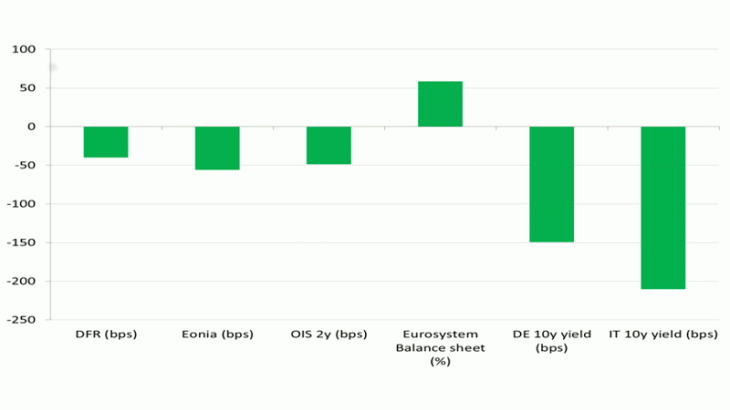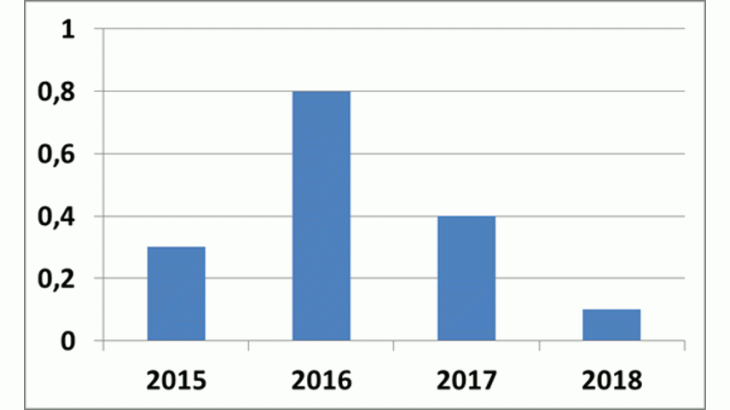Euro Area (EA) inflation has remained below 1% (half the target) since 2014 (Figure 1), with an average rate at 0.20%, despite a very accommodative monetary policy. A major contributor has been the lagged effect of the drop in energy prices between mid-2014 and mid-2015, something on which central banks have no grip. A blunt view may conclude that monetary policy has been inefficient, but that would ignore that inflation would have been even lower in their absence (see Bulletin de la Banque de France, May 2016 ). The risk of a deflationary spiral would have been exacerbated.
The Eurosystem action and its transmission channels through the economy
Since mid-2014, the Eurosystem has implemented three kinds of measures to provide more accommodation and foster the transmission of monetary policy to the real economy: (1) negative policy rates and forward guidance, (2) refinancing and support for lending, especially for firms, and (3) an asset purchase program (APP, public and private, see box).
Transmission of monetary policy is expected to go via at least there channels: signalling of the commitment to keep interest rates at low levels for a prolonged period of time, further easing in credit conditions, and portfolio rebalancing that revaluates asset prices.
The Eurosystem threefold response from mid-2014 to mid-2016
(1) Policy rates were lowered: the main refinancing operations rate (MRO) in three steps, in June 2014, September 2014 and again in March 2016, to 0%; at the same time, the deposit facility rate – which is the floor of the Eurosystem corridor - was lowered to -0.40%. Rate cuts complemented the forward guidance introduced in July 2013. The latter corresponds to a commitment on the future path of interest rates, so as to influence not only the short-term rates, but also longer-term rates which are largely determined by expectations of future short-term rates.
(2) Targeted longer-term refinancing operations programme (TLTRO) were announced in June 2014 and implemented as of September. They are operations that provide financing to credit institutions for periods of up to four years. They offer long-term funding at attractive conditions to banks in order to further ease private sector credit conditions and stimulate bank lending to the real economy. These measures reinforce the ECB’s current accommodative monetary policy stance and strengthen the transmission of monetary policy by further incentivising bank lending to the real economy.
(3) Last and foremost, a first package of quantitative easing focusing on private sector assets linked to loans to the economy, asset backed securities and covered bonds was launched in October 2014. In January 2015, it was extended to Euro area government bonds (PSPP), intended to bring back the ECB balance sheet size toward 3 trillion Eur. It has also been extended in duration (extended in December 2015 from September 2016 to at least March 2017) and in volume (total monthly purchases from 60 bn/month to 80 bn/month in March 2016).
A significant impact of monetary measures on market indicators since 2014
The programmes launched in 2014 and 2015 have led to a significant improvement in financial conditions in the EA. In particular, there was a noted decline in expected future short-term interest rates, an even stronger decrease in the yields on sovereign bonds issued by EA members (Figure 2). These were also passed on to bank rates (e.g. with a drop of 1.1 pp on the rate of credit to non- financial corporations since January 2014), an increase in loans (the total outstanding amounts increased by 3% on the same period), and a depreciation of the euro (the euro effective exchange rate against 38 currencies decreased by 5% over the same period).


